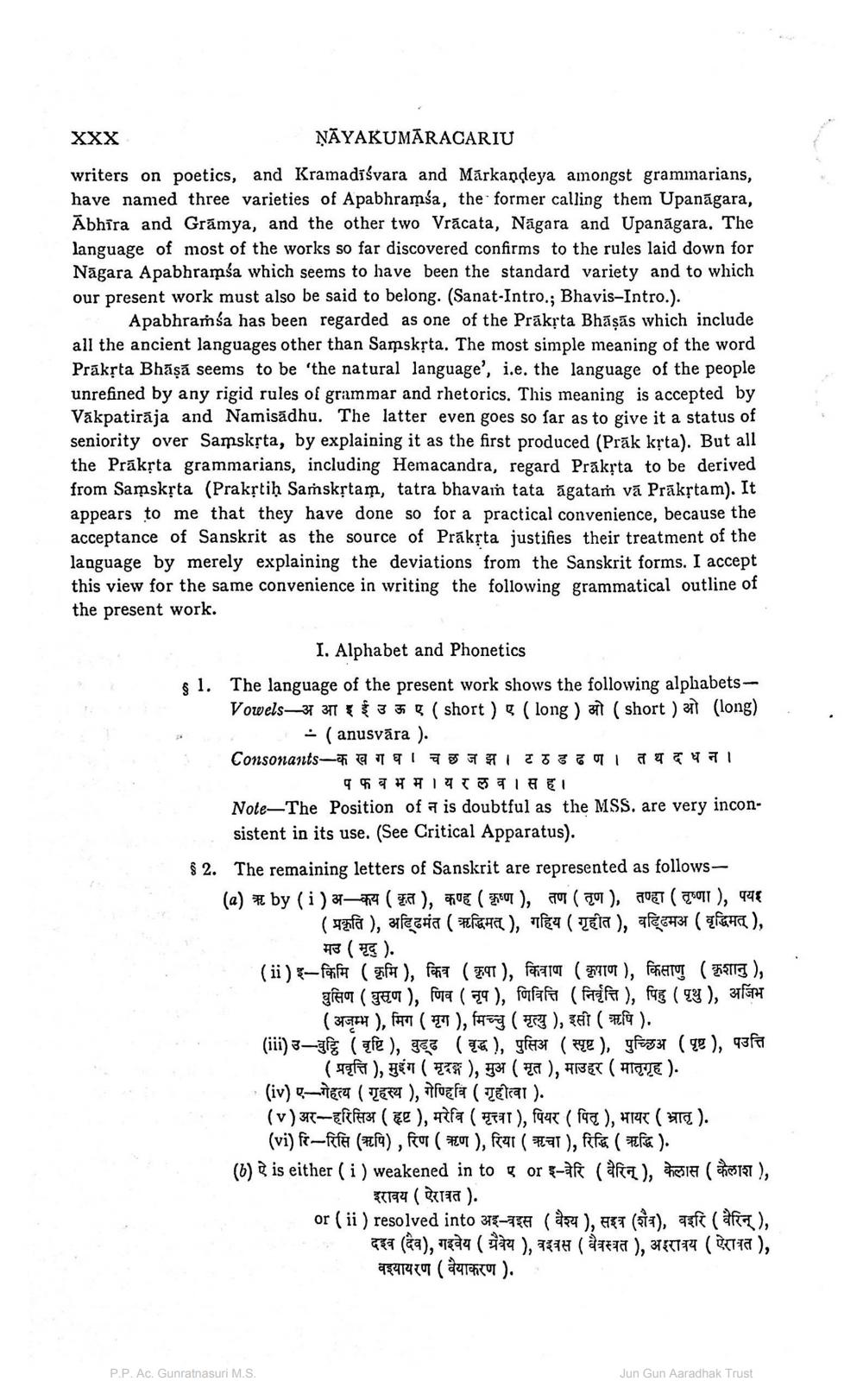________________ XXX NAYAKUMARACARIU writers on poetics, and Kramadisvara and Markandeya amongst grammarians, have named three varieties of Apabhramba, the former calling them Upanagara, Abhira and Gramya, and the other two Vracata, Nagara and Upanagara. The language of most of the works so far discovered confirms to the rules laid down for Nagara Apabhramsa which seems to have been the standard variety and to which our present work must also be said to belong. (Sanat-Intro.; Bhavis-Intro.). Apabhraiba has been regarded as one of the Prakrta Bhasas which include all the ancient languages other than Samskrta. The most simple meaning of the word Praksta Bhasa seems to be 'the natural language', i.e. the language of the people unrefined by any rigid rules of grammar and rhetorics. This meaning is accepted by Vakpatiraja and Namisadhu. The latter even goes so far as to give it a status of seniority over Samskrta, by explaining it as the first produced (Prak krta). But all the Praksta grammarians, including Hemacandra, regard Prakrta to be derived from Samskrta (Prakrtih Samskrtam, tatra bhavain tata agatam va Prakrtam). It appears to me that they have done so for a practical convenience, because the acceptance of Sanskrit as the source of Praksta justifies their treatment of the language by merely explaining the deviations from the Sanskrit forms. I accept this view for the same convenience in writing the following grammatical outline of the present work. I. Alphabet and Phonetics $1. The language of the present work shows the following alphabets rt) ए ( long ) ओ ( short ) ओ (long) - (anusvara ). Consonants-क ख ग घ / च छ ज झ ट ठ ड ढ ण त थ द ध न / प फ ब भ म / य र ल व / स ह / Note-The Position of his doubtful as the MSS. are very inconsistent in its use. (See Critical Apparatus). 82. The remaining letters of Sanskrit are represented as follows(a) ऋ by (i) अ-कय ( कृत), कण्ह ( कृष्ण ), तण ( तृण), तण्हा ( तृष्णा ), पयर (प्रकृति), अढिमंत (ऋद्धिमत् ), गहिय (गृहीत), वढिमअ (वृद्धिमत् ), मउ (मृदु ). (ii) इ-किमि ( कृमि), किव (कृपा), किवाण (कृपाण), किसाणु (कृशानु), घुसिण (घुसृण), णिव ( नृप ), णिवित्ति (निर्वृत्ति ), पिहु ( पृथु ), अजिंभ (अजृम्भ ), मिग ( मृग ), मिच्चु ( मृत्यु ), इप्सी (ऋषि ). (iii) उ-बुट्टि ( वृष्टि ), वुड्ढ (वृद्ध ), पुसिअ ( स्पृष्ट ), पुच्छिअ (पृष्ट ), पउत्ति (प्रवृत्ति), मुइंग ( मृदङ्ग), मुअ (मृत), माउहर (मातृगृह ). (iv) ए-गेहत्य ( गृहस्थ ), गेण्हिवि (गृहीत्वा ). (v) अर-हरिसिअ (हृष्ट ), मरेवि ( मृत्वा), पियर ( पितृ), भायर (भ्रातृ). (vi) रि-रिसि (ऋषि), रिण ( ऋण ), रिया ( ऋचा ), रिद्धि ( ऋद्धि ). () ऐ is either (i) weakened in to ए or इ-बेरि (वैरिन् ), केलास ( कैलाश ), इरावय (ऐरावत ). or (ii) resolved into अइ-वइस (वैश्य ), सइत्र (शैव), वइरि (वैरिन् ), दइव (दैव), गइवेय ( अवेय ), वइवस ( वैवस्वत ), अपरावय (ऐरावत ), वइयायरण ( वैयाकरण ). P.P. Ac. Gunratnasuri M.S. Jun Gun Aaradhak Trust




